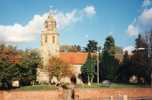 Keyworth Keyworth
St Mary Magdalene
Organ
The first organ (probably a harmonium) seems to date from the 1860s. A new
organ was installed in the chancel in 1891. It was replaced in the 1960s, the
new instrument being located at the back of the north aisle. Today, the pipes
remain there, but the manual has been moved back to the chancel.
The earliest instrumental music played in the church of which we have evidence
was provided in the 1840s by a small orchestra trained by the curate, Lawson
Dykes, who also donated the instruments - they included single and double-bass
viols, clarionet, trombone and serpent. The orchestra probably played in the
minstrels’ gallery above the west end of the nave, which was removed
in the restoration of 1870-2, by which
time a harmonium seems already to have replaced the instrumentalists. The Master
of the National School, Alfred Haskins, was also named as church organist in
Whites Directories of the late 1860s. It may be significant that the glass
in the small window at the west end of the chancel
portrays somebody playing what appears to be a harmonium. This glass, whose
date is unknown, may have been inserted at the time of the 1870s restoration,
when a recently acquired harmonium would still have been a novelty and an apt
subject for the glass.
Keyworth church has had two pipe organs. The first was installed in 1891 at
a total cost of £181 and placed in the chancel. In 1963 it was replaced,
at a cost of £1200, by a reconditioned second-hand organ, built in 1903.
This had previously stood in a Baptist chapel on Southampton Row, London which
was blitzed during World War II. Both manual and pipes were placed at the west
end of the nave, relieving the congestion in the chancel created by its predecessor,
but cutting off the organist from the choir. In 1993 the console was moved
into the chancel, leaving the rest in the nave.
The present organ (originally hand bellows) was built in 1903 by Norman &
Beard. The action is tubular pneumatic (since installation in Keyworth). It
was acquired by Keyworth in 1963 as a reconditioned organ by Henry Groves &
Son of Nottingham. It was upgraded in 1993-4 by Anthony Herrod (organ builder)
with a new console and the installation of an electric action replacing the
tubular pneumatic, together with replacement and additional speaking stops
and accessories.
Specification
| Great |
|
|
|
|
Swell |
|
|
|
|
Pedal |
|
|
| Open diapason |
|
8 |
|
|
Lieblich Gedackt |
|
8 |
|
|
Bourdon |
|
16 |
| Clarabella |
|
8 |
|
|
Viol de Gamba |
|
8 |
|
|
Principal |
|
8 |
| Principal |
|
4 |
|
|
Viox Celeste |
|
8 |
|
|
Bass Flute |
|
8 |
| Fifteenth |
|
2 |
|
|
Gemshorn |
|
4 |
|
|
Octave |
|
4 |
| Nineteenth |
|
1.3 |
|
|
Mixture 15-19-22 Horn |
|
8 |
|
|
Octave Flute |
|
4 |
Couplers & Accessories
Swell to Great, Great to Pedal, Swell to Pedal, Swell suboctave, Swell octave,
Swell unison off
Great & Pedal combinations coupled.
Pistons
Four general thumb pistons (Great) set as follows:
1: Clarabella, 2: Clarabella Principal, 3: Open Diap Principal, 4: Open Diap
Principal fifteenth.
Four general thumb pistons (Swell) set as follows:
| 1 |
Lieblich Gedackt |
Viol di Gamba |
|
|
|
|
| 2 |
|
Viol di Gamba |
Voix Celeste |
|
|
Swell Octave |
| 3 |
Lieblich Gedackt |
Viol di Gamba |
Gemshorn |
|
|
Swell Octave |
| 4 |
Lieblich Gedackt |
Gemshorn |
Mixture |
Horn |
Swell Suboctave |
Swell Octave |
Four general toe pistons (Pedal) set as follows:
1: Bass Flute, 2: Bass Flute Bourdon, 3: Bourdon Principal, 4: Bourdon Principal
Octave
Toe Piston - Swell to Great
Toe Piston - Great to Pedal
| 








